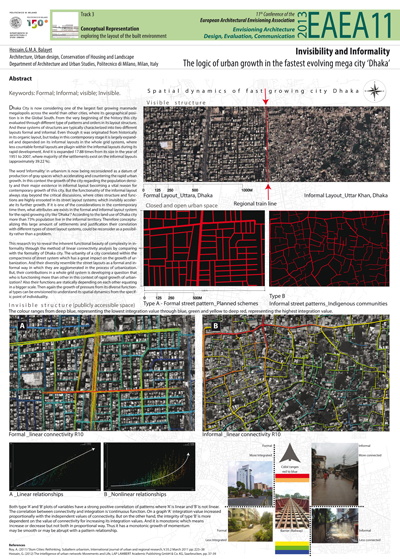11th EAEA Envisioning Architecture: Design, Evaluation, Communication Conference in 2013
Track 3 | Conceptual Representation | Exploring the layout of the built environment
‘Invisibility and informality’: the logic of urban growth in the fastest evolving mega city ‘Dhaka’
Keywords: formal; informal; invisible; visible
ABSTRACT
‘Dhaka City’ is now considering one of the largest fast growing manmade megalopolis across the world than other cities, where its geographical position is in the Global South. From the very beginning of the history this city evaluated through different type of patterns and orders in its layout structure. And these systems of structures are typically characterized into two different layouts formal and informal. Even though it was originated from historically in its organic layout, but today in this contemporary stage it is largely expanded and depended on its informal layouts in the whole grid systems, where less countable formal layouts are plugin within the informal layouts during its rapid development. And it is expanded 17.88 times from its size in the year of 1951 to 2007, where majority of the settlements exist on the informal layouts (approximately 39.22 %).
The word ‘informality’ in urbanism is now being reconsidered as a datum of production of gray spaces which accelerating and countering the rapid urban growth. In this context the growth of the city regarding the population density and their major existence in informal layout becoming a vital reason for contemporary growth of this city. But the functionality of the informal layout always stay beyond the critical discussions, where cities structure and functions are highly enrooted in its street layout systems; which invisibly accelerate its further growth. If it is one of the considerations in the contemporary time then, what attributes are exists in the formal and informal layout system for the rapid growing city like ‘Dhaka’? According to the land use of Dhaka city more than 73% population live in the informal territory. Therefore conceptualizing this large amount of settlements and justification their correlation with different types of street layout systems, could be reconsider as a possibility rather than a problem.
This research try to reveal the inherent functional beauty of complexity in informality through the method of visual graph and density analysis by comparing with the formality of Dhaka city. The urbanity of a city correlated within the compactness of street system which has a great impact on the growth of urbanization. And their diversity resemble the street layouts as a formal and informal way in which they are agglomerated in the process of urbanization. But, their contributions in a whole grid system is developing a question that who is functioning more than other in this context of rapid growth of urbanization? Also their functions are statically depending on each other equating in a bigger scale. Then again the growth of pressure from its diverse functional types can be envisioned to understand its spatial dynamics from the specific point of individuality.
AUTHOR
Hossain G.M.A. Balayet
Architecture, Urban Design, Conservation of Housing and Landscape, Department of Architecture and Urban Studies, Politecnico di Milano, Milan, Italy
